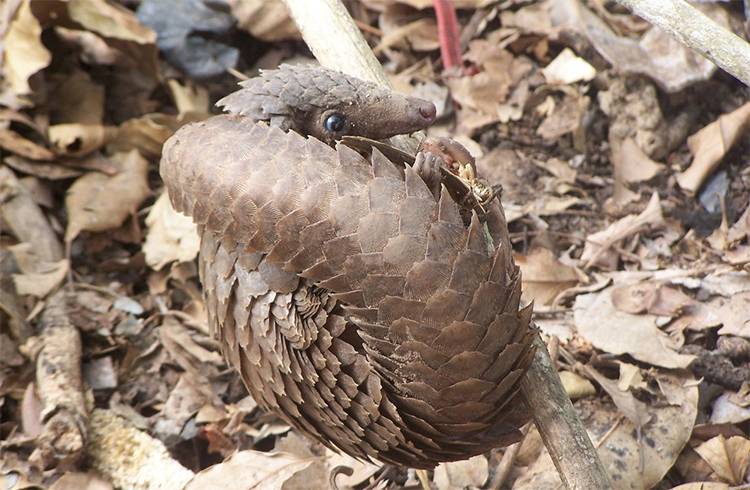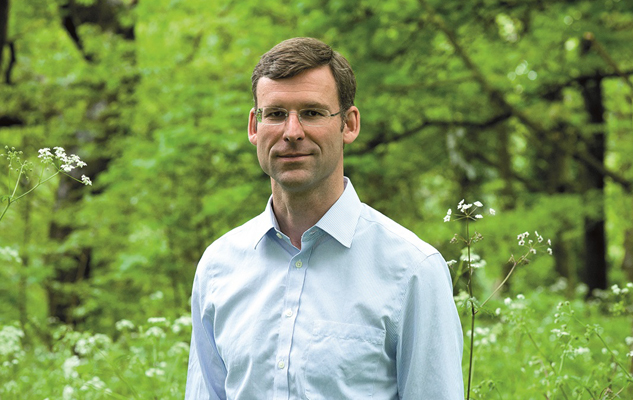Using small-scale data to see bigger patterns in biodiversity loss
University of Sussex research was instrumental in securing a ban on the international trade of pangolins, the world’s only scaly mammal, which is threatened with extinction.
The bigger biodiversity picture
“I have never seen a pangolin in the wild.” This is perhaps a surprising admission from Prof. Jörn Scharlemann, given his important role in highlighting the plight facing the pangolin. But most of his job involves sitting at a computer collating and analysing biodiversity datasets and creating future scenarios rather than traipsing through the forests where they can be found.
“We have very little information on what’s actually happening on Earth. We have telescopes looking to the sky providing detailed information about what’s happening in space. We have satellites looking down on Earth to quantify how the vegetation has changed, but we know very little about how the animals in that vegetation have changed over time.” As a quantitative ecologist he and the researchers he works with are changing that.
“We are piecing [the data] together – it’s like collecting puzzle pieces that are already out there and bringing them together to see the overarching picture,” said Scharlemann.
In the case of the OFFTAKE project , the puzzle pieces are the numbers of wild animals hunted, including the solitary pangolin. This information is collected in Africa and Asia by researchers looking at hunter’s daily catches, interviewing local households about their bush meat consumption or visiting village and local meat markets. This information is then added to the database and analysed for trends, including “hotspots” where species are being exploited at unsustainable rates.
The OFFTAKE project in numbers

- The OFFTAKE project in numbers (text version)
The OFFTAKE project has data collected from the 1970s to today from more than 316 bushmeat markets and hunting sites in 25 African countries with information on 1,282,440 individual animals including mammals, reptiles, amphibians, gastropods and birds and its database is continuing to grow as new studies are being added.
Ingram DJ, et al. (2018) Assessing Africa-wide pangolin exploitation by scaling local data. Conservation Letters 11, e12389.
The overarching picture in their ground-breaking study provided clear and bleak proof that the harvesting of pangolins in Central Africa has dramatically increased. “We show that the proportion of pangolins which have been hunted over time has increased – massively – by about 150%, said Scharlemann. The international research team used data gathered from the 1970s to 2014 from more than 100 hunting sites in 14 African countries. They found that between 0.4 to 2.7 million pangolins are harvested annually from Central African forests, representing an increase of up to 150 percent since 2000. In fact, the most trafficked wild animal is not the elephant or the rhino, but the pangolin.
We show that the proportion of pangolins which have been hunted over time has increased - massively - by about 150%” Professor Jorn Scharlemann
Professor of Conservation Science at the University of Sussex
The collaborative research involving an international team from conservation organisations and universities was led by Daniel Ingram, a PhD student at the University of Sussex supervised by Scharlemann. Pangolin meat and scales are used in traditional medicines in parts of Asia, including China. There is no proof that the scales are effective, as they are just keratin, the same material our hair and fingernails are made from.
This data and analyses were used as evidence by 13 countries in their proposal to the Convention on International Trade in Endangered Species (CITES) to transfer pangolins from Appendix II to I (for species threatened with extinction). In 2016 CITES agreed a total ban on the international trade of all eight pangolin species. The CITES decision shows that quantitative data can have a real impact on policy. But Scharlemann is quick to point out its limitations. “We’ve had an impact in terms of contributing evidence towards the ban on the international trade of pangolins, but it’s hard to know if we have made any difference to pangolins on the ground. International trade is no longer legal, but the whole trade could still go underground or to the black market.”
 White bellied pangolin. Credit: Hugues Akpona, IUCN SSC Pangolin Specialist group.
White bellied pangolin. Credit: Hugues Akpona, IUCN SSC Pangolin Specialist group.
His pessimism is understandable as the CITES directive doesn’t come with the tools to enforce it. That’s left to the often cash-strapped countries where the trade occurs. A study looking at pangolin trade in Gabon, co-authored by Ingram, found the value of pangolins had increased by up to 211%, more than 45 times the rate of inflation. It suggested that local hunters in Gabon are selling increasing numbers of pangolins to Asian workers stationed on the continent for major logging, oil exploration and agro-industry projects and were being transported across remote borders to avoid law enforcement officials.
Scharlemann and the rest of the team now want to make the OFFTAKE project, which initially focussed on Africa, truly global by tracking wildlife harvesting worldwide over time. They also want to make the data freely available. “For decision makers to trust our findings, they need to be able to check the underlying data and be able to repeat our analyses.” But there are issues to be overcome in terms of data ownership and hiding the exact location of where species were hunted. Potential traffickers could use this information to hunt more rare and threatened species.
PREDICTS database holds 3.2 million biodiversity records
Despite his youthful skin, Scharlemann is also a self-declared “grandfather” of another database, called PREDICTS, which has over 3.2 million biodiversity records from over 26,000 sites. It’s the most geographically and taxonomically comprehensive database available, covering everything from soil invertebrates to birds. The collaborative project builds predictions, using the data, about how local biodiversity typically responds to human pressures over time, such as land-use change, human population density, and roads. So what did the data reveal? “The PREDICTS project has shown that we have lost about 14% of local species since human expansion and industrialisation. It’s a massive loss.”
 Jorn Scharlemann
Jorn Scharlemann
The PREDICTS database could also help weigh up the trade-offs that need to be resolved if nations are to achieve the 17 UN Sustainable Development Goals by 2030. These goals include everything from eradicating poverty to preventing climate change and protecting biodiversity. Scharlemann says that some scenarios for reducing climate change, such as converting native forests into biofuel plantations, could have more negative impacts on biodiversity than scenarios resulting in increased climate change. “We have this potential trade-off between climate and biodiversity. So now we need to go back to decision makers and say: how are we going to resolve this? How can we have both? That’s where the models help us.”
Given the scale of biodiversity loss, does he find the work depressing at times? “That’s what I struggle with every day. There is always bad news. But I hope that I have some impact by bringing this data together to highlight these global issues and to make our findings available to decision makers at the highest levels.”
Find out more about the OFFTAKE database
Author: Suzanne Fisher-Murray, University of Sussex
Date published: 3 October 2018
Contact us
Research development enquiries:
researchexternal@sussex.ac.uk
Research impact enquiries:
rqi@sussex.ac.uk
Research governance enquiries:
rgoffice@sussex.ac.uk
Doctoral study enquiries:
doctoralschool@sussex.ac.uk
Undergraduate research enquiries:
undergraduate-research@sussex.ac.uk
General press enquiries:
press@sussex.ac.uk